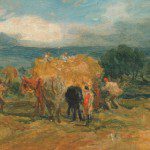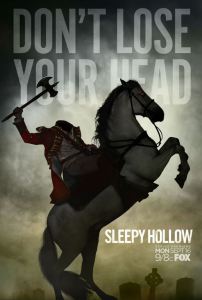 For good (and probably) for ill, “witches”* are going to be a thing on television this Fall. The first shot was fired on Monday night with the premiere of Sleepy Hollow on the Fox Network. Surprisingly, Sleepy Hollow was not completely awful. It’s a buddy cop show featuring a time traveling Ichabod Crane (Tom Mison) up against a headless, horse-riding, Redcoat who is apparently one of the Four Horsemen of the Apocalypse. Crane’s only only chance to stop the Headless One rests with the pistol of police officer Abbie Mills (Nicole Beharie) and George Washington’s Bible (I’m not making that last part up, swear!). It sounds ridiculous, and it pretty much was, but it looked cool and the actors were able to rise above the rather silly dialogue. Park your brain at the door and you might get up caught up in Sleepy Hollow.
For good (and probably) for ill, “witches”* are going to be a thing on television this Fall. The first shot was fired on Monday night with the premiere of Sleepy Hollow on the Fox Network. Surprisingly, Sleepy Hollow was not completely awful. It’s a buddy cop show featuring a time traveling Ichabod Crane (Tom Mison) up against a headless, horse-riding, Redcoat who is apparently one of the Four Horsemen of the Apocalypse. Crane’s only only chance to stop the Headless One rests with the pistol of police officer Abbie Mills (Nicole Beharie) and George Washington’s Bible (I’m not making that last part up, swear!). It sounds ridiculous, and it pretty much was, but it looked cool and the actors were able to rise above the rather silly dialogue. Park your brain at the door and you might get up caught up in Sleepy Hollow.
I was completely digging the first thirty minutes or so, and then we got to the “witches.” I realize that the word witch has several different meanings, and that my usage of the word is not the most common one (I’m a Witch, a practioner of British Traditional Witchcraft), but why are television descriptions of witchcraft so wildly inaccurate? My ire began the moment time traveling Ichabod found the tombstone of his wife, with the grave marker pointing out that she was burnt at the stake for witchcraft in 1782. It’s a pet peeve, but no one was being executed in the United States for witchcraft after 1692, and alleged witches weren’t burned at the stake in the United States either. Yes, television shows have to take dramatic license with things, but to not care a whit about what actually happened back then trivializes the senseless deaths of those who were executed for witchcraft.
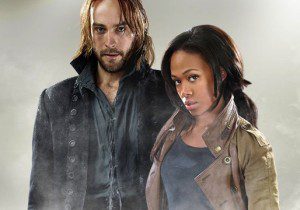 A little further into the episode, we get some backstory via a tape recorder (and the voice of Lex Luthor/Clancy Brown) and find out that there are two different groups of witches somehow involved with the Headless Horseman:
A little further into the episode, we get some backstory via a tape recorder (and the voice of Lex Luthor/Clancy Brown) and find out that there are two different groups of witches somehow involved with the Headless Horseman:
“One hundred witches were put to death in Sleepy Hollow between 1712 and 1816 . . . Town records suggest that members of two different covens integrated into the populace and changed their names to stay hidden, others spread out across the East Coast. Two covens representing good and evil . . . I found hundreds of unsolved cases that just seem to have been ignored; murders, disappearances, and it’s just not here, the cases track through Boston, DC, Manhattan I know they are all connected, I just don’t know how . . .”
I guess it’s cool that there’s at least one group of witches who are “good,” but I can already hear my wife’s relatives asking us if we are “good” or “bad” witches via Sleepy Hollow. Aren’t there other words lazy unimaginative TV writers can use? Why can’t they be warlocks or sorcerers? Just imagine that little bit of exposition above but with Baptists substituted for witches:
“One hundred Baptists were put to death in Sleepy Hollow between 1712 and 1816 . . . Town records suggest that members of two different congregations integrated into the populace and changed their names to stay hidden, others spread out across the East Coast. Two congregations representing good and evil . . . I found hundreds of unsolved cases that just seem to have been ignored; murders, disappearances, and it’s just not here, the cases track through Boston, DC, Manhattan I know they are all connected, I just don’t know how . . .”
Think of the outrage! The Fox Network would be feeding the beast that is Fox News! Talk about corporate synergy!
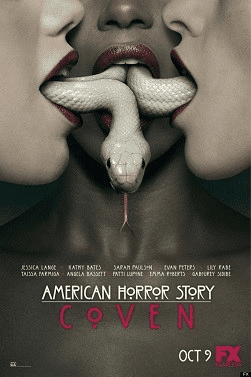 We get more witches in just a couple of weeks when American Horror Story: Coven premieres on FX. The witches here sound a little better, but I’m dismayed at the desire to link them with the Salem witch trials of the 1690’s. It’s not only intellectually dishonest, but it creates a perception that perhaps some of the senseless murders that occurred there were justified. (This summer’s The Conjuring did the same thing, pretty much turning me into a ball of rage for the last half of that movie.) I’m excited by creator Ryan Murphy’s comment that “The witches are really sort of a great allegory and metaphor for any minority group that has been persecuted and has had to go underground . . ” perhaps we’ll get a little sympathy here, mouth snakes be damned.
We get more witches in just a couple of weeks when American Horror Story: Coven premieres on FX. The witches here sound a little better, but I’m dismayed at the desire to link them with the Salem witch trials of the 1690’s. It’s not only intellectually dishonest, but it creates a perception that perhaps some of the senseless murders that occurred there were justified. (This summer’s The Conjuring did the same thing, pretty much turning me into a ball of rage for the last half of that movie.) I’m excited by creator Ryan Murphy’s comment that “The witches are really sort of a great allegory and metaphor for any minority group that has been persecuted and has had to go underground . . ” perhaps we’ll get a little sympathy here, mouth snakes be damned.
Here’s the official show synopsis from FX:
“American Horror Story: Coven” tells the secret history of witches and witchcraft in America. Over 300 years have passed since the turbulent days of the Salem witch trials and those who managed to escape are now facing extinction. Mysterious attacks have been escalating against their kind and young girls are being sent away to a special school in New Orleans to learn how to protect themselves. Wrapped up in the turmoil is new arrival, Zoe (Taissa Farmiga), who is harboring a terrifying secret of her own. Alarmed by the recent aggression, Fiona (Jessica Lange), the long-absent Supreme, sweeps back into town, determined to protect the Coven and hell-bent on decimating anyone who gets in her way.”
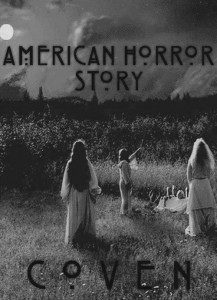 Several descriptions of the show that I’ve come across also make reference to conflicts between the show’s witches and practitioners of New Orleans style Voodoo. Apparently Lilith Dorsey and I are going to have to engage in some sort of magickal face-off to stay true to the spirit of this season’s American Horror Story. If there’s one thing that scares me about this show after seeing the early promotional material, it’s that poster over there on the right. It’s one thing to use the word “witch”; it’s another to mimic Modern Wiccan and Pagan practices. No one takes Methodism and grafts a fictional backstory and cosmology onto it. I’m going to reserve judgement, but I’m wary. On the plus side, the show does star Angela Bassett, Jessica Lange, and Kathy Bates; let’s just hope they don’t screw up Marie Laveau too much.
Several descriptions of the show that I’ve come across also make reference to conflicts between the show’s witches and practitioners of New Orleans style Voodoo. Apparently Lilith Dorsey and I are going to have to engage in some sort of magickal face-off to stay true to the spirit of this season’s American Horror Story. If there’s one thing that scares me about this show after seeing the early promotional material, it’s that poster over there on the right. It’s one thing to use the word “witch”; it’s another to mimic Modern Wiccan and Pagan practices. No one takes Methodism and grafts a fictional backstory and cosmology onto it. I’m going to reserve judgement, but I’m wary. On the plus side, the show does star Angela Bassett, Jessica Lange, and Kathy Bates; let’s just hope they don’t screw up Marie Laveau too much.
(Peg Aloi over on The Witching Hour wrote about American Horror Story: Coven last week. Check it out!)
*I generally capitalize the words Witch and Witchcraft when writing about individuals who have self-identified that way after 1950. I leave it in lower-case in all other instances.
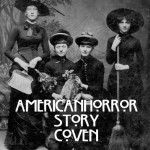 For more on American Horror Story: COVEN from Patheos writers, check out the show’s topic page on the Patheos Entertainment channel.
For more on American Horror Story: COVEN from Patheos writers, check out the show’s topic page on the Patheos Entertainment channel.



